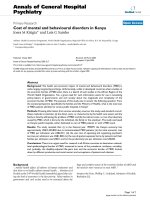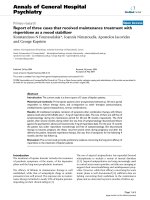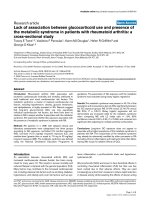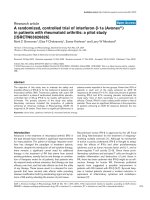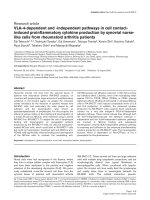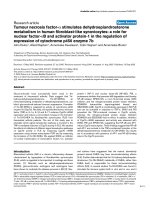Báo cáo y học: " CCR5Δ32 variant and cardiovascular disease in patients with rheumatoid arthritis: a cohort study" ppsx
Bạn đang xem bản rút gọn của tài liệu. Xem và tải ngay bản đầy đủ của tài liệu tại đây (196.24 KB, 6 trang )
RESEARCH ARTICLE Open Access
CCR5Δ32 variant and cardiovascular disease in
patients with rheumatoid arthritis: a cohort study
Luis Rodríguez-Rodríguez
1,2†
, Carlos González-Juanatey
3†
, Mercedes García-Bermúdez
1†
,
Tomas R Vázquez-Rodríguez
4
, Jose A Miranda-Filloy
4
, Benjamin Fernández-Gutiérrez
2
, Javier Llorca
5
, Javier Martin
1
and Miguel A González-Gay
6*
Abstract
Introduction: The aim of our study was to analyze the influence of the CCR5Δ32 polymorphism in the risk of
cardiovascular (CV) events and subclinical atherosclerosis among patients with rheumatoid arthritis (RA).
Methods: A total of 645 patients fulfilling the American Rheumatism Association 1987 revised classification criteria for
RA were studied. Patients were genotyped for the CCR5 rs333 polymorphism using predesigned TaqMan assays. Also,
HLA DRB1 genotyping was performed using molecular-based methods. Carotid intima-media thickness, flow-mediated
endothelium-dependent dilatation (FMD) and endothelium-independent vasodilatation, which were used as surrogate
markers of subclinical atherosclerosis, were measured in a subgroup of patients with no clinical CV disease.
Results: A lower frequency of carriers of the CCR5Δ32 allele among patients with CV events (3.4% versus 11.3%, P =
0.025, odds ratio 0.28, 95% confidence interval (95% CI) 0.06 to 0.89) was observed. However, after adjusting for
gender, age at time of RA diagno sis, and the presence of shared epitope, rheumatoid factor and classic CV risk
factors in the Cox regression analysis, this reduction of CV events in CCR5Δ32 allele carriers was slightly outside the
range of significance (P = 0.097; hazard ratio 0.37 (95% CI 0.12 to 1.19)). Carriers of the CCR5Δ32 deletion also showed
higher FMD values than the remaining patients (CCR5/CCR5Δ32 patients: 7.03% ± 6.61% versus CCR5/CCR5 patients:
5.51% ± 4.66%). This difference was statistically significant when analysis of covariance was performed (P = 0.024).
Conclusions: Our results show a potential influence of the CCR5Δ32 deletion on the risk of CV disease among
patients with RA. This may be due to a protective effect of this allelic variant against the development of vascular
endothelial dysfunction.
Keywords: rheumatoid arthritis, atherosclerosis, cardiovascular disease, genetics, CCR5Δ32, rs333
Introduction
CCR5 is a G protein-coupled receptor that is expressed on
macrophages, monocytes, Th1 cells, immature dendritic
cells, endothelial cells and vascular smooth muscle cells
(VSMCs) [1-4]. The activation of this molecule through
one of its ligands contributes to the survival and accumu-
lation of macrophages [5] during inflammation, to the
recruitment and activation of T cells [6] and to the activa-
tion and secretion of tissue factor [2] of VSMCs. It also
participates in osteoclast formation [1]. Consistent with its
roles, CCR5 is conside red to play a role in both rheuma-
toid arthritis (RA) and atherosclerosis [7].
The CCR5Δ32 (dbSNP rs333) polymorphism is defined
by a 32-bp deletion that leads to a truncated nonfunctional
receptor [8], which is eliminated from the cell surface in
homozygous individuals or its expression is reduced by
20% to 30% in heterozygous individuals [9]. Several studies
have demonstrated a protective effect of the CCR5Δ32
allele in patients with CV disease [10,11], although others
have demonstrated no association [12-14].
CCR5Δ32 deletion also was suggested to have a protec-
tive effect on RA susceptibility in a Spanish cohort [15].
Although other studies couldnotconfirmaprotective
effect of this variant [16], a meta-analysis has suggested a
protective effect [17]. When the influence of the
* Correspondence:
† Contributed equally
6
Division of Rheumatology, Hospital Universitario Marqués de Valdecilla,
IFIMAV, Avenida de Valdecilla s/n, E-39008, Santander, Spain
Full list of author information is available at the end of the article
Rodríguez-Rodríguez et al. Arthritis Research & Therapy 2011, 13:R133
/>© 2011 Rodríguez-Rodríguez et al.; licensee BioMed Central Ltd. This is an open access article distributed under the terms of the
Creative Common s Attribution License (http://creat ivecommons.org/licenses/by/2.0), which permits unrestricted use, distri bution, and
reprodu ction in any medium, provided the original work is properly cited.
CCR5Δ32 polymorphism and disease severity were ana-
lyzed, conflicting results were reported [16,18]. T hese
contradictions may be the result of differences in study
design, study power or the populations assessed; there-
fore, additional data will be helpful to understand the
role of CCR5 gene polymorphisms. Taking all of these
considerations together, the aim of the present study was
to analyze the influence of t he CCR5Δ32 polymorphism
on the risk of CV events and subclinical atherosclerosis
in patients with RA.
Materials and methods
Patients and study protocol
Between March 1996 and March 2008, 660 consecutive
patients who fulfilled the American Rheumatism Associa-
tion 1987 revised classification criteria for RA [19] were
recruited from the rheumatology outpatient clinics of
Hospital Xeral-Calde (Lugo, Spain) and Hospital Clínico
San Carlos (Madrid, Spain). DNA samples were extracted
from these patients at the time of recruitment. Between
December 2009 and January 2010, patients’ clinical
records were examined until death, loss of follow-up or 1
December 2009. Sociodemographic and clinical data
regarding clinical manifestat ions, classic CV risk factors
and history of CV events were registered. Clinical defini-
tions for CV events and classic CV risk factors were
established as previously described [20,21]. Information
on the main demographic characteristics, CV risk factors
and CV events of patients in whom genotyping success
was achieved (n = 645 (97.7%)) is shown in T able 1.
Hospital Xeral-Calde and Hospital Clinico San Carlos are
the referral centers for the population of each respective
area. The first CV event was defined as an event (case) of
CV complication diagnosed at the hospital in a patient
without a history of CV disease.
Endothelial dysfunction was assessed between March
2007 and September 2009 in a random subgroup of
patients in the Lugo cohort with no history of CV dis-
ease. Flow-mediated endothelium-dependent vasodilata-
tion FMD (postischemia) and endothelium-independent
vasodilatation NTG (postnitroglycerin) were assessed on
the basis of a brachial artery reactivity study in 127
patients as previously reported [22,23]. Intraobserver
variability was 1.3% and 1.9%, respectively, based on
repeat ultrasonography in 32 healthy controls. Assess-
ment of the endothelial function of patients undergoing
anti-TNF therapy was performed 24 to 48 hours before
drug administration. Carotid artery intima-media thick-
ness (IMT) was determined in 105 patients as previously
reported [23,24]. The correlation coefficient was 0.98
based on repeat ultrasonography in 20 RA patients and
20 healthy controls. Participants’ written consent was
obtained according to the Declaration of Helsinki, and
the design of the study was approved by the Ethics
Committee of Galicia (Spain) and the Hospital Clinico
San Carlos (Madrid).
Genotyping
CCR5 genotyping
DNA from patients was obtained from whole peripheral
blood using standard methods. Participants were geno-
typed t o determine CCR5 status using TaqMan Assays-
on-Demand from Applied Biosystems following the
manufacturer’s protocol and ana lyze d using the Applied
Biosystems 7900 HT Fast Real-Time PCR Syst em
(Applied Biosystems, Foster City, CA, USA). The typing
was successful in 645 patients (97.7%). Ten percent o f
the samples were regenotyped at random. We observed
no differences from the results obtained before.
Shared epitope determination
Several HLA-DRB1 alleles are associated with suscept-
ibility to RA, encoding a conserved amino acid sequence
at positions 70 to 74 in the third hypervariable region,
called the “shared epitope” [25]. HLA DRB1 typing was
carried out using a reverse dot-blot kit with sequence-
specific oligonucleotide probes (Dynal RELI SSO HLA-
DRB1 Typing Kit; Dynal Biotech, Bromborough, UK). In
Table 1 Demographic characteristics and genotype
distribution of the patients with rheumatoid arthritis
included in the study
a
Variables Patients
(N = 645)
Females 484 (75.0)
Median patient age at time of disease diagnosis,
years (IQR)
56 (45 to 65)
Median follow-up, years (IQR) 13 (7 to 19)
Anti-CCP-positive (N = 470) 283 (60.2)
Rheumatoid factor-positive (N = 635) 474 (74.7)
Shared epitope (N = 579) 366 (63.2)
Cardiovascular events 87 (13.5)
Ischemic heart disease 47 (7.3)
Cerebrovascular accidents 19 (2.9)
Heart failure 23 (3.6)
Peripheral arteriopathy 10 (1.6)
Hypertension (N = 640) 248 (38.8)
Diabetes mellitus (N = 637) 74 (11.6)
Dyslipidemia (N = 621) 282 (45.4)
Obesity (N = 610) 66 (10.8)
Smoking habit (N = 621) 112 (18.0)
CCR5Δ32 rs333
CCR5/CCR5 579 (89.8)
CCR5 /CCR5Δ32 64 (9.9)
CCR5Δ32 /CCR5Δ32 2 (0.3)
CCR5 1,222 (94.7)
CCR5Δ32 68 (5.3)
a
Anti-CCP: anticyclic citrullinated peptide antibodies; IQR: interquartile range.
Values are n (%) except where indicated otherwise.
Rodríguez-Rodríguez et al. Arthritis Research & Therapy 2011, 13:R133
/>Page 2 of 6
our sample, 63.2% of the patients had at least one copy
of the r heumatoid shared epitope, a frequency higher
than that found previously in Spanish individuals with-
out RA [26].
Statistical analysis
Comparison of means was performed using a t-test.
Comparison of proportions between two or more groups
was carried out using a c
2
test or Fisher’s exact test when
required. Hardy-Weinberg equilibrium (HWE) was tested
in the RA patients with and without CV disease. Both
groups were in HWE (P =0.87andP = 0.93, respec-
tively). The study had 80% power f or detecting an odds
ratio (OR) ≥ 2. A Cox regression model was used to esti-
mate the influence of the CCR5 polymorphism on CV
disease. We used the occurrence of at least one CV event
as the outcome. Survival time was defined as “age of the
subjects at” or “ela psed time between RA diagnosis and”
the first CV event, patient’s death, loss of follow-up or 1
December 2009. Patients who died as a result of any
cause other than CV events were considered not to have
had CV events. Proportional hazards assumptions were
tested using Schoenfeld residuals. The results are
expressed as hazard ratios (HRs) with 95% confidence
intervals (95% CIs) and were computed as both crude
analysis and adjusted for age at RA diagnosis, gender and
classic CV risk factors. The selected variables used for
adjustment were selected on the basis of their association
with the outcome (CV event) and the exposure (CCR5
genotype) and because they produced a change > 10% in
the HR.
The association between CCR5Δ32 and carotid IMT,
FMD and NTG was also tested using analysis of covar-
iance (ANCOVA) adjusting for gender, age and duration
of the disease at the time of ultrasonography as well as
for the presence or absence of the shared epitope and tra-
ditional CV risk factors. This study had 80% power to
detect a difference in carotid IMT of 0.1 mm or higher, a
difference of 2.5% or higher in FMD and a difference of
3.5% or higher in NTG. Statistical significance was
defined as P ≤ 0.05. Calculations were performed with
Stata version 10 software (StataCorp LP, College Station,
TX, USA).
Results
Influence of the CCR5Δ32 polymorphism on the risk of
cardiovascular events
We compared the genotypic and allelic frequencies of the
CCR5Δ32 polymorphism between the subgroups of RA
patients with and without CV events (Table 2). We found
a decreased frequency of carriers of the deletion (CCR5/
CCR5Δ32 + CCR5Δ32/CCR5Δ32) among the patients with
CV events (3.4% versus 11.3%, P = 0.025, OR 0.28 ( 95% CI
0.06 to 0.89)). Likewise, the CCR5Δ32 allele frequency was
also decreased among the RA patients with CV events
(1.7% versus 5.8%, P = 0.024, OR 0.28 (95% CI 0.06
to 0.88)).
We performed Cox regression analysis to account for
the variation of risk of the first CV event over time
according to the CCR5Δ32 variant, assuming a domi-
nant model of effect (carriers versus noncarriers of the
deletion) (Table 3). When age was used as a measure of
survival time, to carry at least a copy of the CCR5Δ32
allele was not associated with a lower ri sk of CV disease
over time, in both the crude and adjusted analyses (P =
0.14 and P = 0.14, respec tively). When elapsed time
from RA diagnosis was used, the reduction of CV events
in carriers was slightly outside the range of significance
in the crude analysis (P = 0.078, HR 0.35 (95% CI 0.11
to 1.12)) and in the adjusted analysis (P = 0.097, HR
0.37 (95% CI 0.12 to 1.19)).
Influence of the CCR5Δ32 polymorphism in subclinical
atherosclerosis
Owing to the small number of homozygotes for the
CCR5Δ32 deletion, none of those patients underwent
ultrasonography for the assessment of subclinical athero-
sclerosis. Therefore, the comparisons were performed
between heterozygote and homozygote subjects with two
copies of the allele without the 32-bp deletion. In the
Table 2 Differences between rheumatoid arthritis patients with or without cardiovascular events according to
CCR5Δ32 polymorphism
a
RA patients, n (%)
CCR5 genotype With CV events Without CV events P value OR (95% CI)
CCR5/CCR5 84 (96.6) 495 (88.7) 1
CCR5/CCR5Δ32 3 (3.4) 61 (10.9) 0.029 0.29 (0.06 to 0.92)
CCR5Δ32/CCR5Δ32 0 (0.0) 2 (0.4) 0.99 0.0 (0.0 to 31.63)
CCR5Δ32 carriers 3 (3.4) 63 (11.3) 0.025 0.28 (0.06 to 0.89)
Allele 2
CCR5 171 (98.3) 1,051 (94.2) 1
CCR5Δ32 3 (1.7) 65 (5.8) 0.024 0.28 (0.06 to 0.88)
a
CV: cardiovascular; OR (95% CI): odds ratio with 95% confidence interval; RA: rheumatoid arthritis.
Rodríguez-Rodríguez et al. Arthritis Research & Therapy 2011, 13:R133
/>Page 3 of 6
unadjusted analysis, w e did not observe a significant dif-
ference regarding carotid IMT, FMD or NTG (P =0.32,
P =0.28andP = 0.64, respectively) (Table 4). However,
in the adjusted ANCOVA, we observed a significant asso-
ciation between being heterozygous for the CCR5Δ32
deletion and a higher F MD (P = 0.024) (Table 5). In this
regard, the mean FMD percentage among heterozygotes
was higher than in those without the allelic variation
(7.03% ± 6.61% versus 5.51% ± 4.66%, respectively). Inter-
esti ngly, the mean FMD percentage among heterozygous
patients was considered normal [23].
Discussion
This study is the first to address the role of the CCR5Δ32
deletion in the risk of CV disease in RA patients. We
observed a lower frequency of this variant among the
patients with CV complications. However, in the Cox
regression model, the potential protective role of the
CCR5Δ32 deletion was slightly outside the range o f sig-
nificance. Regarding the surrogate markers of subclinical
atherosclerosis, we observed that RA patients with a copy
of the CCR5 allele containing the 32-bp deletion had a
higher FMD value. In fact, the mean FMD value in those
patients was over the cutoff point for normal endothelial
function observed in our echocardiography laboratory.
These observations suggest a protective effect of the
CCR5Δ 32 deletion against the development of endothe-
lia l dysfunction, an early step in the atherogenic process,
in patients with RA. Although no association of
CCR5Δ32 deletion with carotid IMT was observed in our
series, a significantly lower carotid IMT in the common
carotid artery was found in individuals carrying the
CCR5Δ32 deletion in the Bruneck study [27], which is a
prospective population-based survey of the epidemiologi-
cal pathogenesis of atherosclerosis. Since FMD constitu-
tes a physiologic assessment of endothelial dysfunction
and carotid IMT is an anatomic structural measure of
subclinical atherosclerosis, it is logical that FMD might
beamoreusefuldiagnosticmarkerthancarotidIMTin
the early stages of the disease. In this regard, no relation-
ship between carot id IMT and brachial artery FMD was
found in middle-aged men without a history of CV dis-
ease who were considered to be at low or intermediate
risk for future CV events based on current risk stratifica-
tion algorithms [28]. Brachial FMD and carotid IMT
values may indicate distinct and independent stages in
the complex pathways leading to acce lerated athero-
sclerosisinpatientswithRA.Itwasrecentlyreported
that, in patients with RA without CV disease, the associa-
tion between FMD and carotid IMT values was observ ed
only in patients with long disease duration [29].
As we pointed out in the Introduction, CCR5 seems to
play an important role in the development of athero-
sclerosis. In rodent knockout models, the lack of CCR5
was associated with a reduction in plaque formation and
macrophages, Th1 and smooth muscle cell accumula-
tion, and increased expression of anti-inflammatory
cytokines such as IL-10 [4,30,31]. Furthermore, studies
using an antagonist of the CCR5 and CXCR3 chemokine
receptors [32] or a recombinant RANTES (regulated
upon activation, normal T cell expressed and secreted)
receptor antagonist [33] have demonstrated an attenua-
tion of atherogenesis in low-density lipoprotein recep-
tor-null mice. In hu mans, the presence of the CCR5Δ32
Table 3 Cox regression model to estimate the influence of the CCR5Δ32 polymorphism in the risk of cardiovascular
disease in patients with rheumatoid arthritis
a
Patient group characteristics P value HR (95% CI) P value
b
HR (95% CI)
b
Carriers vs. noncarriers
c
0.14 0.42 (0.13 to 1.33) 0.14 0.42 (0.13 to 1.33)
Carriers vs. noncarriers
d
0.078 0.35 (0.11 to 1.12) 0.097 0.37 (0.12 to 1.19)
a
HR (95% CI): hazard ratio with 95% confidence interval.
b
Analyses adjusted for gender, age at rheumatoid arthritis (RA) diagnosis, presence or absence of shared
epitope, rheumatoid factor, hypertension, diabetes, dyslipidemia, obesity and smoking habit.
c
Using as survival time the patient’s age at the time of the first
cardiovascular event, patient’s death, loss of follow-up or 1 December 2009.
d
Using as survival time the elapsed time between RA diagnosis and the time of the
first cardiovascular event, the patient’s death, loss of follow-up or 1 December 2009.
Table 4 Comparison of carotid artery intima-media thickness, flow-mediated endothelium-dependent (postischemia)
vasodilatation and endothelium-independent vasodilatation according to the CCR5Δ32 polymorphism distribution
a
CCR5Δ32 polymorphism Mean IMT, mm (SD) P value Mean FMD % (SD) P value Mean NTG % (SD) P value
CCR5/CCR5 (n = 95) 0.73 (0.16)
CCR5/CCR5Δ32 (n = 10) 0.79 (0.32)
CCR5Δ32/CCR5Δ32 (n = 0) - 0.32
CCR5/CCR5 (n = 113) 5.51 (4.66) 17.2 (7.64)
CCR5/CCR5Δ32 (n = 14) 7.03 (6.61) 18.21 (8.45)
CCR5Δ32/CCR5Δ32 (n = 0) - 0.28 - 0.64
a
IMT: intima-media thickness; FMD: flow-mediated endothelium-dependent (postischemia) vasodilatation; NTG: endothelium-independent (postnitroglycerin)
vasodilatation.
Rodríguez-Rodríguez et al. Arthritis Research & Therapy 2011, 13:R133
/>Page 4 of 6
deletion, when associated with lower or even absent
expression of the CCR5 molecule on the cell surface [9],
has also been associated with a lower risk of CV disease
in some studies [10,11]. In the present study, we observed
better endothelial function in response to ischemia
among those RA patients carrying the CCR5Δ32 deletion.
However, this fact was not associated with a strong
reduction in the risk of CV disease. Since endothelial dys-
function is an early step in the atherogenic process, these
observations might appear to be contradictory. However,
RA is a chronic inflammatory disease, and it i s well
known that the persistence of chronic inflammatory bur-
den is of major importance in the development of CV
events in these patients [20]. Because of that, it is possible
that a chronic inflammatory status might overcome the
potential protective effect that the CCR5Δ32 deletion
mayhaveagainsttheprogressionoftheatherogenic
process.
Conclusions
In summary, our results show a potential influence of the
CCR5Δ32 deletion on the risk of CV disease in patients
with RA. This may be due to a protective effect of this
allelic variant against the development of vascular
endothelial dysfunction. However, further studies need to
be carried out to replicate our findings and confirm the
role of this molecule in the atherosclerosis disease
observed in patients with RA.
Abbreviations
ANCOVA: analysis of covariance; anti-CCP: anti-cyclic citrullinated peptide
antibodies; bp: base pair; CI: confidence interval; CV: cardiovascular; FMD:
endothelium-dependent flow-mediated vasodilatation (postischemia); HLA:
human leukocyte antigen; HR: hazard ratio; IMT: intima-media thickness; NTG:
endothelium-independent (postnitroglycerin) vasodilatation; RA: rheumatoid
arthritis; RF: rheumatoid factor; TNF: tumor necrosis factor.
Acknowledgements
This study was supported by two grants from “Fondo de Investigaciones
Sanitarias” PI06-0024 and PS09/00748 (Spain). This work was partially
supported by the RETICS Program, RD08/0075 (RIER) from the “Instituto de
Salud Carlos III” (ISCIII).
Author details
1
Instituto de Parasitología y Biomedicina López-Neyra, C.S.I.C., Parque
Tecnológico de Ciencias de la Salud, Avenida del Conocimiento s/n Armilla,
Granada E-18100, Spain.
2
Division of Rheumatology, Hospital Clinico San
Carlos, c/Profesor Martín Lagos, s/n Madrid E-28040, Spain.
3
Division of
Cardiology, Hospital Xeral-Calde, c/Dr.Ochoa s/n, Lugo E-27004, Spain.
4
Division of Rheumatology, Hospital Xeral-Calde, c/Dr. Ochoa s/n, Lugo E-
27004, Spain.
5
Department of Epidemiology and Computational Biology,
School of Medicine, University of Cantabria, IFIMAV, and CIBER Epidemiología
y Salud Pública (CIBERESP), Avenida Herrera Oria s/n, E-39011 Santander,
Spain.
6
Division of Rheumatology, Hospital Universitario Marqués de
Valdecilla, IFIMAV, Avenida de Valde cilla s/n, E-39008, Santander, Spain.
Authors’ contributions
LRR and MGB carried out genotyping, participated in the design of the
study and the data analysis, and helped to draft the manuscript. CGJ
performed the ultrasonographic studies, participated in the design of the
study and the data analysis, and helped to draft the manuscript RPM
participated in genotypin g and data analysis. TRV, JAMF and LR participated
in the acquisition and interpretation of data. BF was involved in the
acquisition and interpretation of data and in revising it critically for
important intellectual content. JM and MAGG made substantial contributions
to the conception and design of the study, the acquisition of data, study
coordination, helped to draft the manuscript, and gave final approval of the
version to be published. All authors read and approved the final version of
the manuscript for publication. MAGG and JM share senior authorship of this
manuscript.
Competing interests
The authors declare that they have no competing interests.
Received: 28 February 2011 Revised: 27 June 2011
Accepted: 16 August 2011 Published: 16 August 2011
References
1. Oba Y, Lee JW, Ehrlich LA, Chung HY, Jelinek DF, Callander NS, Horuk R,
Choi SJ, Roodman GD: MIP-1α utilizes both CCR1 and CCR5 to induce
osteoclast formation and increase adhesion of myeloma cells to marrow
stromal cells. Exp Hematol 2005, 33:272-278.
2. Schecter AD, Calderon TM, Berman AB, McManus CM, Fallon JT,
Rossikhina M, Zhao W, Christ G, Berman JW, Taubman MB: Human vascular
smooth muscle cells possess functional CCR5. J Biol Chem 2000,
275:5466-5471.
3. Lucas AD, Greaves DR: Atherosclerosis: role of chemokines and
macrophages. Expert Rev Mol Med 2001, 3:1-18.
4. Oppermann M: Chemokine receptor CCR5: insights into structure,
function, and regulation. Cell Signal 2004, 16:1201-1210.
5. Tyner JW, Uchida O, Kajiwara N, Kim EY, Patel AC, O’Sullivan MP, Walter MJ,
Schwendener RA, Cook DN, Danoff TM, Holtzman MJ: CCL5-CCR5
interaction provides antiapoptotic signals for macrophage survival
during viral infection. Nat Med 2005, 11:1180-1187.
6. Crane IJ, Xu H, Wallace C, Manivannan A, Mack M, Liversidge J, Marquez G,
Sharp PF, Forrester JV: Involvement of CCR5 in the passage of Th1-type
cells across the blood-retina barrier in experimental autoimmune uveitis.
J Leukoc Biol 2006, 79:435-443.
7. Zhao Q: Dual targeting of CCR2 and CCR5: therapeutic potential for
immunologic and cardiovascular diseases. J Leukoc Biol 2010, 88:41-55.
8. Samson M, Libert F, Doranz BJ, Rucker J, Liesnard C, Farber CM, Saragosti S,
Lapouméroulie C, Cognaux J, Forceille C, Muyldermans G, Verhofstede C,
Burtonboy G, Georges M, Imai T, Rana S, Yi Y, Smyth RJ, Collman RG,
Doms RW, Vassart G, Parmentier M: Resistance to HIV-1 infection in
Caucasian individuals bearing mutant alleles of the CCR-5 chemokine
receptor gene. Nature 1996, 382:722-725.
9. Pacheco SE, Gibbs RA, Ansari-Lari A, Rogers P: Intranasal immunization
with HIV reverse transcriptase: effect of dose in the induction of helper
T cell type 1 and 2 immunity. AIDS Res Hum Retroviruses 2000,
16:2009-2017.
Table 5 Comparison of carotid artery intima-media
thickness, flow-mediated endothelium-dependent
(postischemia) vasodilatation and endothelium-
independent vasodilatation according to a recessive
pattern of effect of CCR5Δ32 polymorphism in an
analysis of covariance model
a
P value
CCR5Δ32 group IMT FMD NTG
Carriers vs. noncarriers 0.77 0.024 0.11
a
FMD: flow-mediated endothelium-dependent vasodilatation; IMT: carotid
artery intima-media thickness; NTG: endothelium-independent
(postnitroglycerin) vasodilatation. Analyses were adjusted for gender, age at
the time of ultrasonography, follow-up time, and presence or absence of
rheumatoid shared epitope, hypertension, diabetes, dyslipidemia, obesity and
smoking habit.
Rodríguez-Rodríguez et al. Arthritis Research & Therapy 2011, 13:R133
/>Page 5 of 6
10. González P, Alvarez R, Batalla A, Reguero JR, Alvarez V, Astudillo A,
Cubero GI, Cortina A, Coto E: Genetic variation at the chemokine
receptors CCR5/CCR2 in myocardial infarction. Genes Immun 2001,
2:191-195.
11. Szalai C, Duba J, Prohászka Z, Kalina A, Szabó T, Nagy B, Horváth L,
Császár A: Involvement of polymorphisms in the chemokine system in
the susceptibility for coronary artery disease (CAD): coincidence of
elevated Lp(a) and MCP-1 -2518 G/G genotype in CAD patients.
Atherosclerosis 2001, 158:233-239.
12. Petrkova J, Cermakova Z, Lukl J, Petrek M: CC chemokine receptor 5
(CCR5) deletion polymorphism does not protect Czech males against
early myocardial infarction. J Intern Med 2005, 257:564-566.
13. Apostolakis S, Baritaki S, Kochiadakis GE, Igoumenidis NE, Panutsopulos D,
Spandidos DA: Effects of polymorphisms in chemokine ligands and
receptors on susceptibility to coronary artery disease. Thromb Res 2007,
119:63-71.
14. Ghilardi G, Biondi ML, Turri O, Pateri F, D’ Eril GM, Scorza R: Genetic control
of chemokines in severe human internal carotid artery stenosis. Cytokine
2008, 41:24-28.
15. Gómez-Reino JJ, Pablos JL, Carreira PE, Santiago B, Serrano L, Vicario JL,
Balsa A, Figueroa M, de Juan MD: Association of rheumatoid arthritis with
a functional chemokine receptor, CCR5. Arthritis Rheum 1999, 42:989-992.
16. Kohem CL, Brenol JC, Xavier RM, Bredemeier M, Brenol CV, Dedavid e
Silva TL, de Castilhos Mello A, Cañedo AD, Neves AG, Chies JA: The
chemokine receptor CCR5 genetic polymorphism and expression in
rheumatoid arthritis patients. Scand J Rheumatol 2007, 36:359-364.
17. Prahalad S: Negative association between the chemokine receptor CCR5-
Δ32 polymorphism and rheumatoid arthritis: a meta-analysis. Genes
Immun 2006, 7:264-268.
18. Garred P, Madsen HO, Petersen J, Marquart H, Hansen TM, Freiesleben
Sørensen S, Volck B, Svejgaard A, Andersen V: CC chemokine receptor 5
polymorphism in rheumatoid arthritis. J Rheumatol 1998, 25:1462-1465.
19. Arnett FC, Edworthy SM, Bloch DA, McShane DJ, Fries JF, Cooper NS,
Healey LA, Kaplan SR, Liang MH, Luthra HS, Medsger TA Jr, Mitchell DM,
Neustadt DH, Pinals RS, Schaller JG, Sharp JT, Wilder RL, Hunder GG: The
American Rheumatism Association 1987 revised criteria for the
classification of rheumatoid arthritis. Arthritis Rheum 1988, 31 :315-324.
20. Gonzalez-Gay MA, Gonzalez-Juanatey C, Lopez-Diaz MJ, Piñeiro A, Garcia-
Porrua C, Miranda-Filloy JA, Ollier WE, Martin J, Llorca J: HLA-DRB1 and
persistent chronic inflammation contribute to cardiovascular events and
cardiovascular mortality in patients with rheumatoid arthritis. Arthritis
Rheum 2007, 57:125-132.
21. Gonzalez-Juanatey C, Llorca J, Martin J, Gonzalez-Gay MA: Carotid intima-
media thickness predicts the development of cardiovascular events in
patients with rheumatoid arthritis. Semin Arthritis Rheum 2009, 38:366-371.
22. Gonzalez-Juanatey C, Llorca J, Miranda-Filloy JA, Amigo-Diaz E, Testa A,
Garcia-Porrua C, Martin J, Gonzalez-Gay MA: Endothelial dysfunction in
psoriatic arthritis patients without clinically evident cardiovascular
disease or classic atherosclerosis risk factors. Arthritis Rheum 2007,
57:287-293.
23. Gonzalez-Gay MA, Gonzalez-Juanatey C, Vazquez-Rodriguez TR, Martin J,
Llorca J: Endothelial dysfunction, carotid intima-media thickness, and
accelerated atherosclerosis in rheumatoid arthritis. Semin Arthritis Rheum
2008, 38:67-70.
24. Gonzalez-Juanatey C, Llorca J, Garcia-Porrua C, Martin J, Gonzalez-Gay MA:
Effect of anti-tumor necrosis factor α therapy on the progression of
subclinical atherosclerosis in severe rheumatoid arthritis. Arthritis Rheum
2006, 55:150-153.
25. Gregersen PK, Silver J, Winchester RJ: The shared epitope hypothesis: an
approach to understanding the molecular genetics of susceptibility to
rheumatoid arthritis. Arthritis Rheum 1987, 30:1205-1213.
26. van der Woude D, Lie BA, Lundström E, Balsa A, Feitsma AL, Houwing-
Duistermaat JJ, Verduijn W, Nordang GB, Alfredsson L, Klareskog L, Pascual-
Salcedo D, Gonzalez-Gay MA, Lopez-Nevot MA, Valero F, Roep BO,
Huizinga TW, Kvien TK, Martín J, Padyukov L, de Vries RR, Toes RE:
Protection against anti-citrullinated protein antibody-positive
rheumatoid arthritis is predominantly associated with HLA-DRB1*1301: a
meta-analysis of HLA-DRB1 associations with anti-citrullinated protein
antibody-positive and anti-citrullinated protein. Arthritis Rheum 2010,
62:1236-1245.
27. Afzal AR, Kiechl S, Daryani YP, Weerasinghe A, Zhang Y, Reindl M, Mayr A,
Weger S, Xu Q, Willeit J: Common CCR5-del32 frameshift mutation
associated with serum levels of inflammatory markers and
cardiovascular disease risk in the Bruneck population. Stroke 2008,
39:1972-1978.
28. Yan RT, Anderson TJ, Charbonneau F, Title L, Verma S, Lonn E: Relationship
between carotid artery intima-media thickness and brachial artery flow-
mediated dilation in middle-aged healthy men. J Am Coll Cardiol 2005,
45:1980-1986.
29. Gonzalez-Juanatey C, Llorca J, Gonzalez-Gay MA: Correlation between
endothelial function and carotid atherosclerosis in rheumatoid arthritis
patients with long-standing disease. Arthritis Res Ther 2011, 13:R101.
30. Quinones MP, Martinez HG, Jimenez F, Estrada CA, Dudley M, Willmon O,
Kulkarni H, Reddick RL, Fernandes G, Kuziel WA, Ahuja SK, Ahuja SS: CC
chemokine receptor 5 influences late-stage atherosclerosis.
Atherosclerosis 2007, 195:e92-e103.
31. Braunersreuther V, Zernecke A, Arnaud C, Liehn EA, Steffens S,
Shagdarsuren E, Bidzhekov K, Burger F, Pelli G, Luckow B, Mach F, Weber C:
Ccr5 but not Ccr1 deficiency reduces development of diet-induced
atherosclerosis in mice. Arterioscler Thromb Vasc Biol 2007, 27:373-379.
32. van Wanrooij EJ, Happé H, Hauer AD, de Vos P, Imanishi T, Fujiwara H, van
Berkel TJ, Kuiper J: HIV entry inhibitor TAK-779 attenuates atherogenesis
in low-density lipoprotein receptor-deficient mice. Arterioscler Thromb
Vasc Biol 2005, 25:2642-2647.
33. Veillard NR, Kwak B, Pelli G, Mulhaupt F, James RW, Proudfoot AE, Mach F:
Antagonism of RANTES receptors reduces atherosclerotic plaque
formation in mice. Circ Res 2004, 94:253-261.
doi:10.1186/ar3444
Cite this article as: Rodríguez-Rodríguez et al.: CCR5Δ32 variant and
cardiovascular disease in patients with rheumatoid arthritis: a cohort
study. Arthritis Research & Therapy 2011 13:R133.
Submit your next manuscript to BioMed Central
and take full advantage of:
• Convenient online submission
• Thorough peer review
• No space constraints or color figure charges
• Immediate publication on acceptance
• Inclusion in PubMed, CAS, Scopus and Google Scholar
• Research which is freely available for redistribution
Submit your manuscript at
www.biomedcentral.com/submit
Rodríguez-Rodríguez et al. Arthritis Research & Therapy 2011, 13:R133
/>Page 6 of 6


